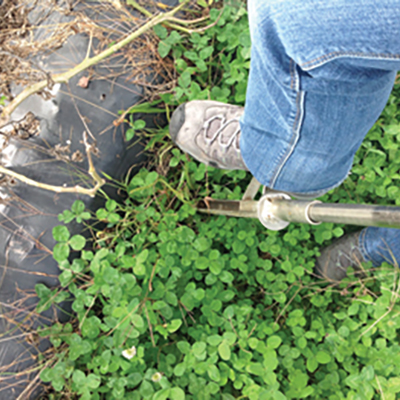The impacts of climate chaos on Astarte Farm have forced us to look for solutions that provide increased long-term resilience in our soil systems, and biochar has shown good promise in moving us toward that goal. Biochar is a paradoxical substance. It is both an ancient agricultural practice developed thousands of years ago in the Amazonian Basin, and at the same time a relatively new approach to enhancing and stabilizing soil fertility.
While it is inert on its own, it becomes a haven for a complex of microbiology. It is not a fertilizer, but freely absorbs and releases plant nutrients as needed. While is has a dry, almost crystalline appearance when freshly made, it readily absorbs water and releases it when needed. It is important to start with a high-quality biochar, but to be truly effective it is equally important how you use it, and how you prepare it in advance for use.
The first challenge many of us face when we decide to try biochar is finding a reputable source or figuring out the science of making biochar. At Astarte Farm we started out making biochar in a "double barrel" retort, which we found the design for online. But we could only produce about 15-20 pounds of char per firing and it was a fairly time-consuming task.
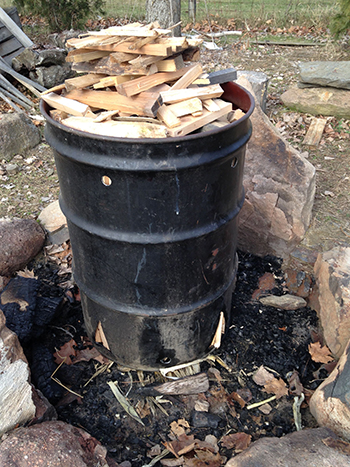
Here is the author's "double barrel" retort used to make his first few batches of biochar.
We were lucky to have a lot of clean scrap wood from various construction jobs on the farm, it was wintertime and we really only made a few batches for entertainment and educational purposes. It might make sense to try this method in the fall if you have a bumper crop of tomatoes to process, because there is a lot of waste heat generated.
The simplest test for a high-quality biochar is the hand wash test. Rub some of the char between your hands and then see if they can come clean with just water, or if you need to use soap and hot water. The need for soap would indicate the presence of tars or oils that may not be beneficial to your soil. Biochar is a powerful substance, with a complex lattice structure similar to the activated charcoal used in water filters.
It has been said that a single piece of biochar the size of a grain of rice contains within its layers the surface area of two football fields. Because of its innate purifying attributes, it is essential to inoculate or charge it with as much active biology as possible before use. In order to prevent biochar from simply absorbing the existing biological activity in our soil and short-circuiting our established soil food web, we have used a variety of inoculation methods over the last three seasons.
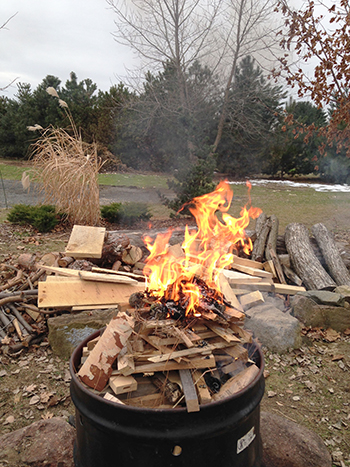
Starting the fire. For more on the author's upside-down fire technique,
Drenches of aerated compost tea or worm casting tea have been an economical approach for us when dealing with fresh biochar, but additions of Organic Materials Review Institute (OMRI) listed biologic agents like EM-1 or powdered mycorrhizae are always welcome. Liquid drenches also help address the dust issue that often accompanies biochar use.
We mix the char by transferring it between bulk bags with flat nosed spades, sprinkling in powdered mycorrhizae and soaking the mixture alternately with the liquids. It can be a lot of manual chopping and mixing, sometimes rolling the bulk bag around, trying to avoid noses full of black dust!

The physical structure of well-produced biochar provides an intricate, porous lattice that is 85% open space, like a sponge. Biochar will soak up excess moisture and any available nutrients in in our soils, and thus become a haven for complex biological activity during those times when adequate moisture or growing roots are absent. We like to exploit both of those benefits when we use biochar on our farm, and we begin with our compost based potting soil mixture.
We have found that adding 10% by volume pre-inoculated or “charged” biochar to our potting soil greatly enhances the moisture holding capacity. When the sun is at its highest in May, June and July, that addition of biochar reduces our daily propagation house watering regime from four to three times daily.

Later on in the burn with the top on to restrict the amount of air that gets to the fire.
While it is difficult to prove that we produce superior transplants by using the additional biochar in our potting soil, we have a loyal following of home gardeners who swear by them year after year. It is important to note that many commercial producers of composts and potting soils have already begun routinely adding a low percentage of biochar to their products to ward off the effects of persistent herbicide residues and heavy metals that make their way into the waste stream through animal manures and yard clippings.
We have used three methods of applying biochar on our fields with variable results. One of the first batches that we were able to acquire was intended to be a part of our bed preparation for a spring asparagus planting. Unfortunately, it was not a well-prepared material and contained chunks of biochar from thumb-sized to half-fist-sized. We did our best to pulverize and thoroughly charge the biochar and then spread it by hand on the beds we had laid out for planting. We used our small Italian spader to deeply incorporate the biochar with the hope that the spading action would further break down the chunks.
The end result was disappointing. Inconsistent plant growth has been evident since the first season, and some of the heaviest weed pressure we have experienced on our farm is concentrated in the asparagus beds. A much more successful method was used when planting our first no-till garlic beds.
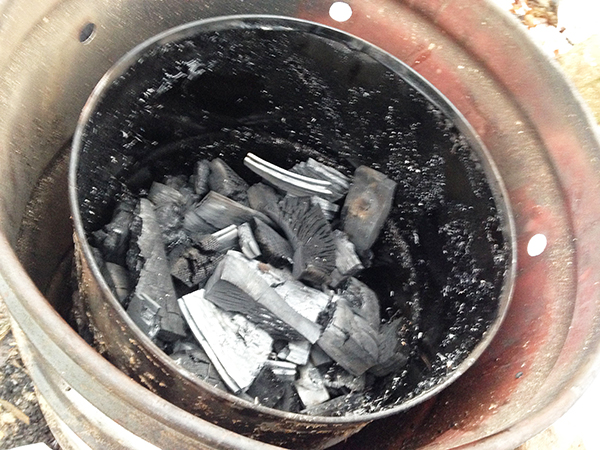
When everything has cooled off, this is what the finished biochar looks like.
You can see how the burn takes place in a barrel inside a barrel, thus the name "double barrel" retort.
Again, we hand spread pre-inoculated biochar on the designated garlic beds, but it was from another source and had a much finer grain. We then covered it with two inches of compost and pushed the garlic cloves down into dibbled holes. The crop was very successful, both in terms of high yield and low weed pressure, and the beds were in great shape for the following crops.
From those first two experiments, combined with further reading on biochar, we began to consider the possibility of combining our applications of biochar and compost. Our local compost supplier agreed to create a 20% biochar/80% compost blend for us that suits our needs perfectly. While we still use our custom pre-inoculation methods for the biochar that we add to our potting soil, we are content to use the “raw” biochar in the field blend. The longer it sits in the compost, the more charged the biochar becomes, and the ease of application out-weighs any loss of biodiversity.
Because we work largely from transplants there is an ongoing inoculation or “seeding” of our production beds with abundant biological activity. The biochar dust problem has been entirely eliminated on our end, and the longer the compost sits, the more thoroughly it is loaded up with fungi and bacteria. We spread the mix at various rates on our production beds, depending upon previous bed applications, expected crop, etc. It varies between a half inch to two inches in depth, or one to four yards per 180' X 3' production bed.
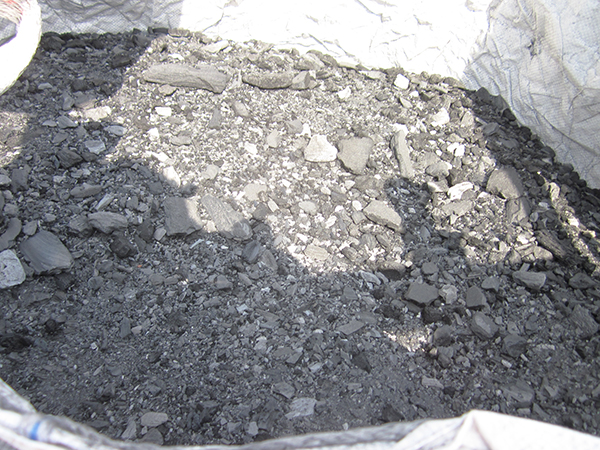
The biochar after it has been pulverized.
Another lesson learned from our first year’s experience has been a deep appreciation for the value of surface applications. One of the particular attributes of biochar is its attractiveness to earthworms. Perhaps their digestive tracts appreciate the abrasive qualities of a fine grit biochar, or perhaps they like the abundant fungal threads embedded in the pores of biochar.
Whatever the reason, when the compost/biochar blend is laid out on the surface, earthworms will readily make repeated trips up and down to effectively move the material into the lower soil profiles. The importance of this interaction can hardly be overstated because worm castings fortified with biochar are strong, long-lasting building blocks of humus and soil organic matter, and the worm passageways greatly enhance rain penetration, retention and drainage.
Taken in conjunction, all of the above factors contribute to our soils’ ability to retain moisture, nutrients and oxygen. The incredible lattice structure of biochar enables it to absorb nutrients, water and a host of fungal and microbial life – and then release them upon contact with a plant’s roots. This buffering effect creates a more resilient soil on our farm with the added benefit for the planet of direct carbon sequestration.
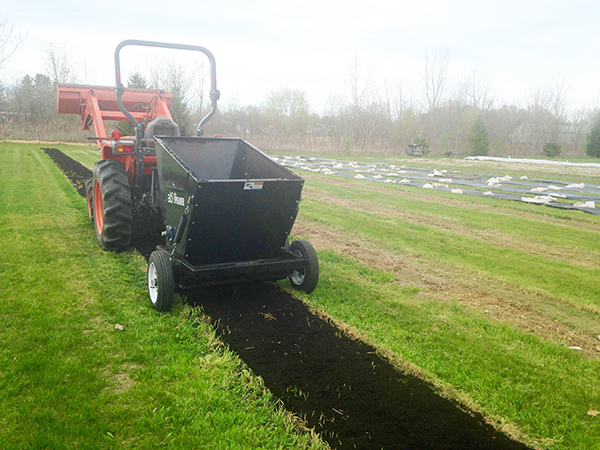
The author using a drop spreader to apply a 20/80 biochar/compost blend. All images courtesy of the author.
We have endured several challenging seasons since we first started working with biochar. Droughty years and years with excessive rainfall have not seriously affected our harvests and we are pleased to hear from our wholesale customers that our produce holds exceptionally well in their coolers and stands out in its appearance and flavor. Biochar by itself will not fix all soil-related problems, because it is just one piece of the incredibly complex puzzle that makes up a healthy soil.
Since it can persist for decades in the soil, reasonable caution should be exercised before any application. Mixing it with compost in advance or at least layering it underneath compost is good insurance against unintended consequences. But actively charging it with the widest variety of available biological activity will create the most positive outcomes, and those rewards promise long-lasting benefits.
Starting with a half-acre market garden in Syracuse NY in 1971, Dan Pratt progressed through an 80-acre farm in Rocky Branch, KY, cooperated on a 2,000-acre farm in Summertown, TN and in the early 90’s grew a CSA for 80 families in Morristown, NJ. He finally settled on 6.5 acres in Hadley, MA in 1999 where he sold certified organic produce almost exclusively at farmers markets. While having sold the farm in 2014, he remains actively involved with the farm’s management, helping to oversee its conversion to a wholesale operation using 100% no-till methods. More info at astartefarm.com.

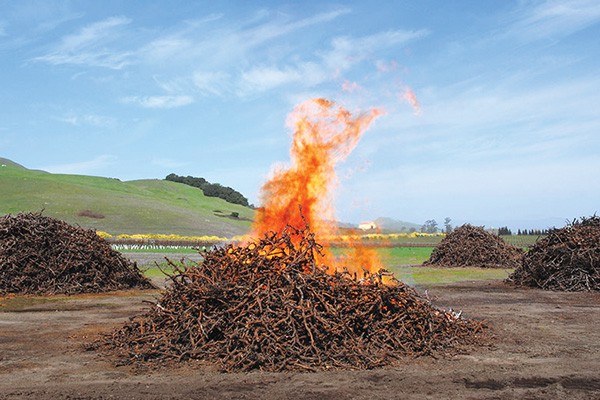 There is, with all of us, a lens through which we see the world. And while each of ours is different—informed by our past, by our present, where we have come from—a common lens we can all share is the recognition that our globe is changing.
There is, with all of us, a lens through which we see the world. And while each of ours is different—informed by our past, by our present, where we have come from—a common lens we can all share is the recognition that our globe is changing. 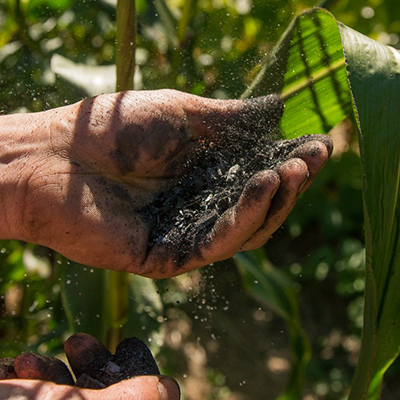
 Charcoal is a naturally occurring form of carbon. Charcoal is a byproduct of burned ecosystems such as forests and prairies that captures the carbon in plant matter and preserves it in a form that can stay in the soil for between several hundred and 10,000 years. Known as recalcitrant carbon, charcoal captures organic matter in its pores, creating areas of “concentrated labile carbon,” which is the most accessible form of carbon for the microbial community. In addition, charcoal can capture nutrients and water, supplying a broad array of fertility needs for plants. Biochar is what charcoal is called when used for agricultural purposes.
Charcoal is a naturally occurring form of carbon. Charcoal is a byproduct of burned ecosystems such as forests and prairies that captures the carbon in plant matter and preserves it in a form that can stay in the soil for between several hundred and 10,000 years. Known as recalcitrant carbon, charcoal captures organic matter in its pores, creating areas of “concentrated labile carbon,” which is the most accessible form of carbon for the microbial community. In addition, charcoal can capture nutrients and water, supplying a broad array of fertility needs for plants. Biochar is what charcoal is called when used for agricultural purposes.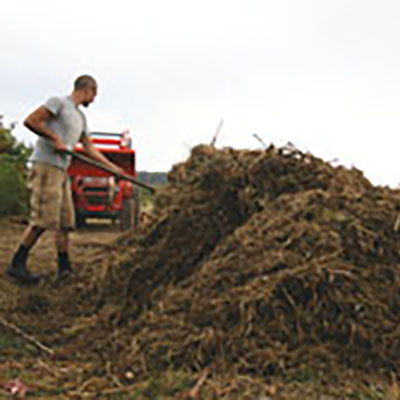
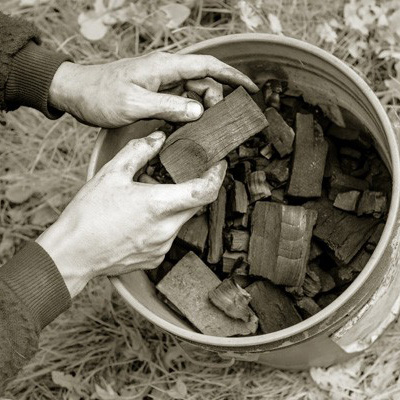
 This is the second of two articles about biochar, the term for charcoal when it is used as a soil amendment. For the first article, detailing the author’s involvement in an on-farm study of biochar from the October 2017 GFM,
This is the second of two articles about biochar, the term for charcoal when it is used as a soil amendment. For the first article, detailing the author’s involvement in an on-farm study of biochar from the October 2017 GFM, 

.png)


 Julia Asherman appeared on my radar screen a number of years ago because she was a regular presence at the Southern Sustainable Agriculture Working Group conferences where I’ve spoken many times. Colleagues pointed her out to me as a person to watch because she was tough and smart and she was going to make something of herself as a farmer. We became conference buddies. So, when I had the good fortune to get invited to speak at the Georgia Organics Conference in Athens this winter, I knew right away I wanted to take that opportunity to visit Julia at her place, Rag & Frass Farm in Jeffersonville, Georgia.
Julia Asherman appeared on my radar screen a number of years ago because she was a regular presence at the Southern Sustainable Agriculture Working Group conferences where I’ve spoken many times. Colleagues pointed her out to me as a person to watch because she was tough and smart and she was going to make something of herself as a farmer. We became conference buddies. So, when I had the good fortune to get invited to speak at the Georgia Organics Conference in Athens this winter, I knew right away I wanted to take that opportunity to visit Julia at her place, Rag & Frass Farm in Jeffersonville, Georgia.
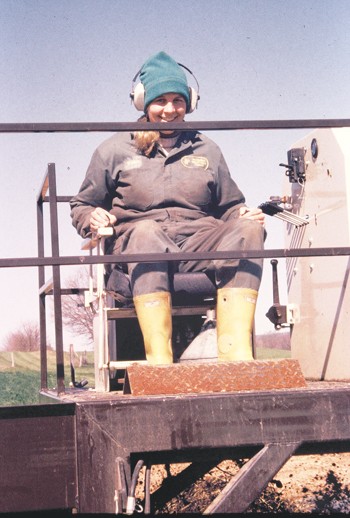 Farmer to Farmer Profile
Farmer to Farmer Profile
 We at Four Winds Farm in Gardiner, New York have developed a no-till approach to farming that uses a lot of compost – 40 yards per acre. When we first developed our model 20 years ago, our market garden was small, only 1.5 acres, and we got our compost from an off-farm source. As we expanded, it made sense that we figure out a way of making our own compost.
We at Four Winds Farm in Gardiner, New York have developed a no-till approach to farming that uses a lot of compost – 40 yards per acre. When we first developed our model 20 years ago, our market garden was small, only 1.5 acres, and we got our compost from an off-farm source. As we expanded, it made sense that we figure out a way of making our own compost. 
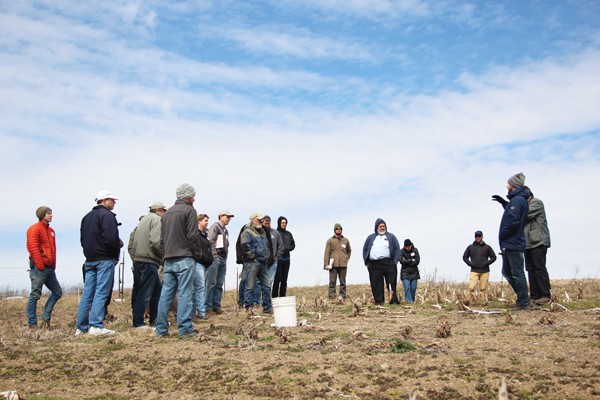 Excessive phosphorous is a problem on many farms that rely solely or primarily on compost as a source of fertility. One way to manage the issue is to apply only enough compost to meet the potassium needs of the crop, and rely on other fertilizers to meet the remaining nutrient needs. For a more detailed analysis of the issue, read on. This the first installment in a series of articles about the
Excessive phosphorous is a problem on many farms that rely solely or primarily on compost as a source of fertility. One way to manage the issue is to apply only enough compost to meet the potassium needs of the crop, and rely on other fertilizers to meet the remaining nutrient needs. For a more detailed analysis of the issue, read on. This the first installment in a series of articles about the 